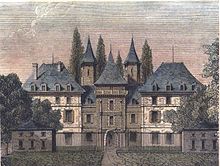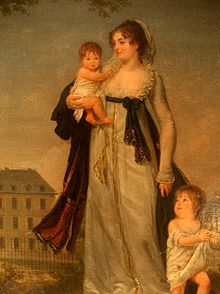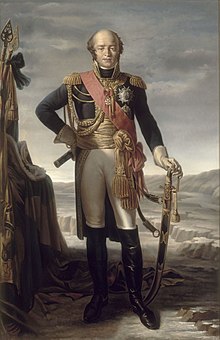Louis-Nicolas Davout
Louis-Nicolas d'Avout (French pronunciation: [lwi nikɔla davu]; 10 May 1770 – 1 June 1823), better known as Davout, 1st Prince of Eckmühl, 1st Duke of Auerstaedt, was a French military commander and Marshal of the Empire who served during both the French Revolutionary Wars and the Napoleonic Wars. His talent for war, along with his reputation as a stern disciplinarian, earned him the nickname "The Iron Marshal" (Le Maréchal de fer). He is ranked along with Marshals André Masséna and Jean Lannes as one of Napoleon's finest commanders.[1][2] His loyalty and obedience to Napoleon were absolute. During his lifetime, Davout's name was commonly spelled Davoust - this spelling appears on the Arc de Triomphe and in much of the correspondence between Napoleon and his generals.
Early life

Davout was born in the small village of
French Revolutionary Wars

On the outbreak of the French Revolution, Davout embraced its principles. He was chef de bataillon in a volunteer corps in the campaign of 1792, and distinguished himself at the Battle of Neerwinden the following spring. He had just been promoted to general of brigade when he was removed from the active list because of his noble birth. After he divorced his wife in 1794 he served in the Rhine campaign of 1796, and accompanied General Louis Desaix in the Egyptian expedition of Napoleon Bonaparte.[6]
On his return, he did not take part in the Battle of Marengo, where his friend Desaix was killed while making a decisive contribution to the victory.[3]: 65 Napoleon, who had great confidence in his abilities, finally promoted him to general of division and arranged his marriage to his sister Pauline's sister-in-law Aimée Leclerc, thus making him part of Napoleon's extended family, and gave him a command in the grenadiers of the Consular Guard.
Napoleonic Wars

At the ascension of Napoleon as emperor in 1804, Davout was named as one of the original 18 Marshals of the Empire. Davout was the youngest and least experienced the generals promoted to marshal, which earned him the hostility of other generals throughout his career. On 18 June 1805 he was present at the Battle of Blanc-Nez and Gris-Nez after joining a Batavian flotilla, headed for Boulogne, as an observer.
As commander of the
Davout added to his renown in the battles of
In 1810 he was sent to Hamburg when
In April 1813, on his return from Russia with 4,000, the remains of 70,000 men,

Davout's military character has been interpreted as cruel and he had to defend himself against many attacks upon his conduct at Hamburg. He was a stern disciplinarian, who exacted rigid and precise obedience from his troops, and consequently his corps was more trustworthy and exact in the performance of its duty than any other. For example, Davout forbade his troops from plundering enemy villages, a policy he would enforce by the use of the death penalty. Thus, in the early days of the Grande Armée, the III Corps tended to be entrusted with the most difficult work. He was regarded by his contemporaries as one of the ablest of Napoleon's marshals.
Hundred Days

Upon the first restoration of the Bourbon monarchy, he retired into private life, openly displaying his hostility to the Bourbons, and when Napoleon returned from Elba, Davout rejoined him.[6] Appointed Minister of War, he reorganized the French Army insofar as time permitted, and he was so indispensable to the war department that Napoleon kept him in Paris during the Waterloo campaign. To what degree his skill and bravery would have altered the fortunes of the campaign of 1815 can only be surmised, but Napoleon has been criticized for his failure to avail himself in the field of the services of the best general he then possessed.[6]
Davout directed the gallant, but hopeless, defense of Paris after the
Later life

Upon the second restoration, Davout was deprived of his titles and was exiled to Louviers on 27 December 1815. When some of his subordinate generals were proscribed, he demanded to be held responsible for their acts, as executed under his orders, and he endeavoured to prevent the condemnation of Ney. After half a year, the hostility of the Bourbons towards Davout faded and he became reconciled to the monarchy. In 1817, his rank and titles were restored and in 1819, he became a member of the Chamber of Peers.[6]
In 1822, Davout was elected mayor of Savigny-sur-Orge, an office he held for a year. His son Louis-Napoléon was also mayor of the city from 1843 to 1846. A main square bears their name in the city, as does a boulevard in Paris.[24][25]
Davout died in Paris on 1 June 1823. His remains rest in the Père Lachaise Cemetery, where an elaborate tomb marks his grave.
Honours and awards

Davout held the following honours and awards:[26]
- Knight Grand Cross of the Order of the Legion of Honour[27]
- Knight of the Order of the Iron Crown
- Grand Cross and Star of the Virtuti Militari
- Knight Grand Cross of the Order of the White Eagle
- Knight of the Order of Christ
- Knight Grand Cross of the Military Order of St. Henry
- Knight Grand Cross of the Military Order of Max Joseph
- Knight Grand Cross of the Royal Order of St. Stephen of Hungary
- Knight of the Military Order of Maria Theresa
- Knight Grand Cross of the Order of the Elephant
Personal life
This section needs additional citations for verification. (December 2020) |

Davout was known as a methodical person in both military and personal affairs. Within the army and among his social peers, he was often considered cold and distant; while respected, he was not well-liked. During times of peace, he preferred to spend time with his family and care for his home, rather than cultivate his high social standing.[citation needed]
Because of his stubborn personality and limited social skills, he developed many enemies and antagonists within the army's officer corps, notably
Perhaps his fiercest anger was directed towards Bernadotte, who he perceived to have failed to come to his aid at Auerstadt, though close enough to observe the smoke and hear the cannon fire.[citation needed] His anger was so intense that Davout requested to settle the matter with a personal duel, averted only by Napoléon's personal intervention. Bernadotte was eventually sent back to Paris in disgrace after being caught by Napoleon retreating without orders at the battle of Wagram.[citation needed] Bernadotte then caught the eye of the Swedish ambassador, looking for a well-connected French officer to take on the role of heir to the Swedish throne. [28] When Sweden threw in her lot against Napoleon in the War of the Sixth Coalition, Davout personally asked to be placed opposite Bernadotte's contingent, in order to gain retribution for the latter's betrayal. But with Davout assigned to defend Hamburg (which he did, up to and beyond Napoleon's abdication), they never did face each other in battle.[28]
Of the other Marshals, Davout had the best relations with Michel Ney,
Family

Davout was also noted for his loyalty to his long-time second wife, 19 June 1782 – Paris, 17 December 1868), whom he married in 1801 and who remained with him until his death. Their marriage was loving and the couple seem to have been faithful to each other despite very long periods of separation. They had eight children, four of whom died in childhood:
- Paul (1802–1803)
- Joséphine (1804–1805)
- Antoinette Joséphine (1805 – 19 August 1821), married in 1820 to Achille, Comte Félix-Vigier (1801–1868)
- Adèle Napoleone (June 1807 – 21 January 1885), married on 14 March 1827 to Étienne, Comte de Cambacérès (1804 – 20 December 1878)
- Napoleon (1809–1810)
- Napoleon Louis, 2nd Duke of Auerstedt, 2nd and last Prince of Eckmühl (6 January 1811 – 13 June 1853), who died unmarried and without issue
- Jules (1812–1813)
- Adelaide-Louise (8 July 1815 – 6 October 1892), married on 17 August 1835 to François-Edmond de Couliboeuf, Marquis de Blocqueville (1789–1861)
The title of duke went to the descendants of Louis-Nicolas' brother Charles Isidor (1774–1854) by his marriage in 1824 to Claire de Cheverry (1804–1895). He also had a sister Julie (1771–1846), married in 1801 to Marc-Antoine Bonnin de La Bonninière, 1st Count de Beaumont (1763–1830), and another brother, Alexandre-Louis-Edme, 1st Baron d'Avout (1773–1820), married in 1808 to Alire Parisot (1786–1856).[30] The youngest daughter, Adelaide-Louise, marquise de Blocqueville, left provision in her will for the name of her father to be given to a lighthouse. In 1897, the
References
- ^ "Louis Davout". Napoleonic Guide. Retrieved 28 July 2015.
- ^ Chandler, David G. (1987). Napoleon's Marshals. p. 94. MacMillan, New York.
- ^ ISBN 1-85367-396-X.
- ^ a b Six, Georges (1934). "D'Avout ou Davout (Louis-Nicolas duc d'Awerstaedt et prince d'Eckmühl)". Dictionnaire biographique des généraux et amiraux français de la Révolution et de l'Empire: 1792–1814 (in French). Vol. 1. Paris: Librairie Historique et Nobilaire. pp. 296–297.
- ISBN 0-297-79124-9.
- ^ a b c d e f g h One or more of the preceding sentences incorporates text from a publication now in the public domain: Chisholm, Hugh, ed. (1911). "Davout, Louis Nicolas". Encyclopædia Britannica. Vol. 7 (11th ed.). Cambridge University Press. pp. 870–871. Cites as sources:
- The Marquise de Blocqueville (Davout's daughter) (1870–1880, 1887). Le Maréchal Davout raconté par les siens et lui-même. Paris.
{{cite book}}: CS1 maint: numeric names: authors list (link) - Chenier (1866). Davout, duc d'Auerstaedt. Paris.
{{cite book}}: CS1 maint: location missing publisher (link)
- The Marquise de Blocqueville (Davout's daughter) (1870–1880, 1887). Le Maréchal Davout raconté par les siens et lui-même. Paris.
- ^ Shosenberg, James W. (October 2009). "Napoleon's Double Knock-out Punch". Military History. 23 (7): 22.
- ^ Helmut Stubbe da Luz, Swantje Naumann: Die französischen Besatzer in Hamburg. Zeugnisse zu den Jahren 1811-1814, p. 227
- ^ Correspondance de Napoleon, Tome XXIV, 18911, p. 28
- ^ 1812: The March on Moscow by Paul Britten Austen
- ^ Napoléon Et la Grande Armée en Russie, Ou, Examen Critique de L'ouvrage de M. Le Comte Ph. de Ségur by Gaspard Baron Gourgaud (1825), p. 398
- ^ Adam Zamoysky (2004) Moscow 1812, p. 422
- ^ Wilson, p. 274. Other sources state that Davout's baggage was captured earlier that day east of Krasny, or the previous day during the fighting with Eugène near Eskovo. Wilson's narrative seems most credible.
- ISBN 1-84415-089-5
- ^ Digby, p. 205
- ^ Helmut Stubbe da Luz: Le maréchal Davout, „le beau siège de Hambourg“ en 1813/14 et „le nom français“. In: Francia 36 (2009), p. 181–207.
- ISBN 978-1-137-40648-4
- ^ Chambers, William. and Chambers, Robert., ed. (1890). "Hamburg". Chambers's Encyclopædia: A Dictionary of Universal Knowledge, New Edition Vol. 5. London: William & Robert Chambers. pp. 527.
- ^ a b Knight, Charles. Ed (1858) "Davout, Louis Nicholas", Cyclopædia of Biography Vols. and II. London: Bradbury And Evans: pp. 533
- ^ Madelin, Louis.(1967). The Consulate and the Empire: 1809–1815 Vol. 2 (translated from the French by E.F. Buckley). New York: AMS Press. pp. 459.
- ^ Thornton, Michael J. (1968) Napoleon After Waterloo: England and the St. Helena Decision. Stanford:Stanford University Press. pp. 6–11
- ^ Gourgaud, Gaspar (1904). Talks of Napoleon at St Helena with General Baron Gourgaud. Translated by Latimer, Elizabeth Wormley. Chicago: A. C. McClurg. p. 264.
- ^ Vachée, Jean-Baptiste-Modeste-Eugène (1914) Napoleon at Work: London: A. and C. Black. pp. 174
- ^ "Google query". www.google.it. Retrieved 28 July 2015.
- ^ "Google query for the square". www.google.it. Retrieved 28 July 2015.
- ^ Annuaire de la pairie et de la noblesse de France et des maisons souveraines de l'Europe et de la diplomatie (in French). Bureau de la Publ. 1845. p. 95.
- ^ Almanach impérial. Testu. 1810.
- ^ ISBN 978-0-8093-0691-6.
- ^ He was first married, in 1791, to Adelaide Séguenot (c. 1768 – 1795) and later divorced in 1794
- ^ Valynseele, Joseph (1957). Les maréchaux du Premier empire : leur famille et leur descendance (in French).
Further reading
- Potocka-Wąsowiczowa, Anna z Tyszkiewiczów. Wspomnienia naocznego świadka. Warszawa: Państwowy Instytut Wydawniczy, 1965.
- Gallaher, John G. (2000). The Iron Marshal. A Biography of Louis N. Davout. London: The Greenhill Books.


